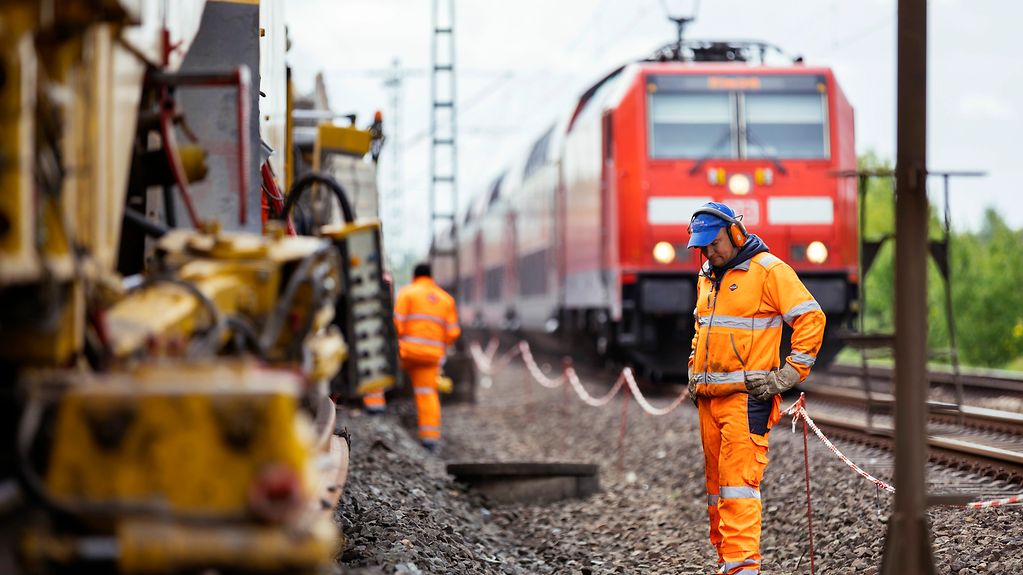Adopted by the Federal Cabinet
Germany is a key industrial location and therefore relies on a high-performance transport infrastructure with no bottlenecks or traffic jams, which is why the Federal Government has introduced new legislation to speed up and simplify planning and approval procedures in the transport sector.
3 min reading time

The Federal Government has passed the Transport Authorisation Procedures Acceleration Act with the specific aim of speeding up rail infrastructure projects
Photo: picture alliance/Geisler-Fotopress
he Transport Authorisation Procedures Acceleration Act is part of the Federal Government's third process acceleration package and is intended to simplify and expedite the current lengthy and complicated planning and approval procedures for the expansion of key railway routes and road projects.
What are the specific provisions of the legislation?
The Transport Authorisation Procedures Acceleration Act provides for the following regulations:
Rail network expansion
The rail network will be expanded more rapidly, whilst simultaneously protecting the "overriding public interest" and simplifying the rules relating to species protection for particularly important rail projects. The protection scope has not been reduced in any way, which means that it will be possible to increase rail transport in future. This will make a significant contribution to the implementation of climate protection goals in the transportation sector.
Elimination of traffic jams and bottlenecks on motorways
Economic development can be hindered by traffic bottlenecks and traffic jams that result in daily standstills on the motorway network, which is why the state and Länder can collaborate to establish the "overriding public interest" for projects aimed at the elimination of bottlenecks on motorways, resulting in smoother traffic flows and greater climate protection. It only applies to upgrades of existing motorway sections rather than to new motorways.
Bridge repairs
Older bridges are often overloaded by the volume of contemporary traffic, which is why repairing and upgrading them can make an important contribution to resolving traffic bottlenecks and congestion. The requirement to obtain a permit for enlarging bridges in the course of maintenance works has now been completely eliminated, as has the mandatory environmental impact assessment, which has reduced the overall planning and approval period by half.
Note: Under the previous planning and approval processes, it took five to 18 years to upgrade or extend a bridge.
Uniform approval deadline for Trans-European Network (TEN) transport projects
A four-year approval period has been introduced for the first time for transport projects in all sectors (road, rail, waterway, ports, air transport) that fall within the core Trans-European Networks (TENs).
Wind turbines and photovoltaic plants to be constructed alongside motorways
The simplified approval procedures introduced by the road traffic authorities will mean that it will be possible to erect wind turbines alongside motorways more rapidly and will also allow for the construction of photovoltaic systems whenever motorways are constructed or modified, to which end the usable areas have been specifically designated.
Digitalisation of the transportation infrastructure
The increased digitalisation of planning and approval procedures, such as for rail and road projects, will also expedite the expansion of the transport infrastructure because it will be possible to complete the entire process, from application to approval, online.
What other measures have been adopted?
The Federal Cabinet also adopted three white papers concerning species protection, rail infrastructure, the implementation of the recommendations of the Rail Acceleration Commission and the Digital Portal for Environmental Data, which is available at umwelt.info, the overall objective
being to rapidly move more traffic onto the railways and to increase the efficiency of the traffic flows. So these documents represent another basis for the acceleration of rail infrastructure, and the plan is to act on their recommendations before the end of the year.
Important environmental data needed for planning and permit approvals will be bundled and made more easily available at umwelt.info, a digital portal for environmental data, for which the Federal Government has also set out specific key points. This will contribute to transparency as well as expediting procedures.